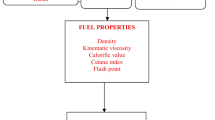Abstract
To produce diesel fuel from renewable organic material such as vegetable oils, it has for a number of years been known that triglycerides can be hydrogenated into linear alkanes in a refinery hydrotreating unit over conventional sulfided hydrodesulfurization catalysts. A number of new reactions occur in the hydrotreater, when a biological component is introduced, and experiments were conducted to obtain a more detailed understanding of these mechanisms. The reaction pathways were studied both in model compound tests and in real feed tests with mixtures of straight-run gas oil and rapeseed oil. In both sets of experiments, the hydrogenation of the oxygen containing compounds was observed to proceed either via a hydrodeoxygenation (HDO) route or via a decarboxylation route. The detailed pathway of the HDO route was further illuminated by studying the hydroprocessing of methyl laurate into n-dodecane. The observed reaction intermediates did not support a simple stepwise hydrogenation of the aldehyde formed after hydrogenation of the connecting oxygen in the ester. Instead, it is proposed that the aldehyde formed is enolized before further hydrogenation. The existence of an enol intermediate was further corroborated by the observation that a ketone lacking α-hydrogen (that cannot be directly enolized) had a much lower reactivity than a corresponding ketone with α-hydrogen. In real feed tests, the complete conversion of rapeseed oil into linear alkanes at mild hydrotreating conditions was demonstrated. From the gas and liquid yields, the relative rates of HDO and decarboxylation were calculated in good agreement with the observed distribution of the n-C17/n-C18 and n-C21/n-C22 formed. The hydrogen consumption associated with each route is deduced, and it was shown that hydrogen consumed in the water-gas-shift and methanization reactions may add significant hydrogen consumption to the decarboxylation route. The products formed exhibited high cetane values and low densities. The challenges of introducing triglycerides in conventional hydrotreating units are discussed. It is concluded that hydrotreating offers a robust and flexible process for converting a wide variety of alternative feedstocks into a green diesel fuel that is directly compatible with existing fuel infrastructure and engine technology.






Similar content being viewed by others
References
Stockle M (2007) Hydrocarb Process 86:77
Plass L, Reimelt S (2007) Hydrocarb Eng 86:71
Mikkonen S (2008) Hydrocarb Process 87:63
Bournay L, Casanave D, Delfort B, Hillion G, Chodorge JA (2005) Catal Today 106:190
Iki H, Iguchi Y, Koyama A (2006) In: Proc. 16th Saudi Arabia-Japan Joint Symposium, 5-6 Nov
Nunes PP (1984) Ph.D. Thesis: “Hydrocraquage de l’huile de soja sur des catalyseurs au rhodium et au ruthenium supportes”. Université Pierre et Marie Curie, Paris
Nunes PP, Brodzki D, Bugli G, Djega Mariadassou G (1985) Revista De Quimica Industrial 54:9
Nunes PP, Brodzki D, Bugli G, Djega Mariadassou G (1986) Revue De l’Institut Francais du Pétrole 41(3):421
Prasad YS, Bakhshi NN (1985) Appl Catal 18:71
Gusmao J, Brodzki D, Djega-Mariadassou G, Frety R (1989) Catal Today 5:533
da Rocha Filho GN, Brodzki D, Djega-Mariadassou G (1993) Fuel 72:543
Chow PW (1993) US Patent 5233109
Weisz PB, Haag WO, Rodewald PG (1979) Science 206:57
Dos Anjos JRS, Gonzalez WDA, Lam YL, Frety R (1983) Appl Catal 5:299
Craig W, Soveran DW (1991) US Patent 4992605
Stumborg M, Wong A, Hogan E (1996) Bioresour Technol 56:13
Monnier J, Tourigny G, Wong A, Hogan EN, Stumborg M (1998) US Patent 5705722
Gomes JR (2006) US Patent Application 2006/0186020
Şenol Oİ, Viljava T-R, Krause AOI (2005) Catal Today 106:186
Şenol Oİ, Viljava T-R, Krause AOI (2005) Catal Today 100:331
Kubicka D, Simacek P, Kolena J, Lederer J, Sebor G (2004) In: IPC 2007, 43rd Int. Pet. Conf., 24–26 Sept
Simacek P, Kubicka D, Sebor G, Pospisil M (2007) In: IPC 2007, 43rd Int. Pet. Conf., 24–26 Sept
Huber GW, O’Connor P, Corma A (2007) Appl Catal A 329:120
Furimsky E (2000) Appl Catal A 199:147
Elliott DC (2007) Energ Fuel 21:1792
Huang X, King DL (2007) In: ACS 234th National Meeting, Boston, 25–29 Aug
Brignac GB, Touvelle MS, Smiley RJ (2005) US Patent 6893554
Author information
Authors and Affiliations
Corresponding author
Rights and permissions
About this article
Cite this article
Donnis, B., Egeberg, R.G., Blom, P. et al. Hydroprocessing of Bio-Oils and Oxygenates to Hydrocarbons. Understanding the Reaction Routes. Top Catal 52, 229–240 (2009). https://doi.org/10.1007/s11244-008-9159-z
Published:
Issue Date:
DOI: https://doi.org/10.1007/s11244-008-9159-z




